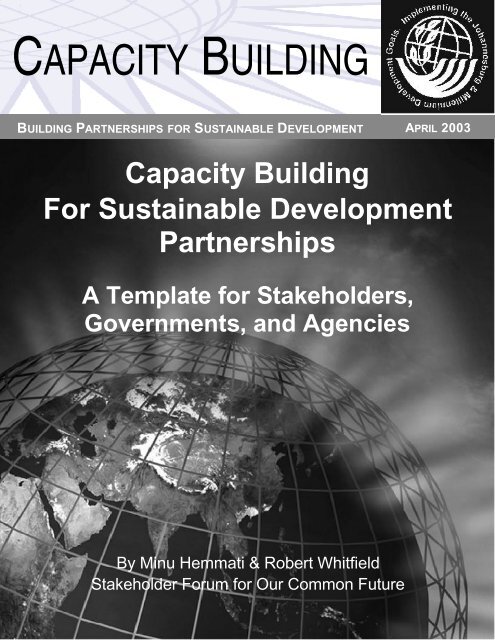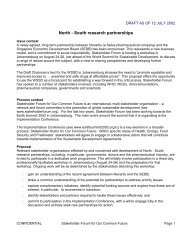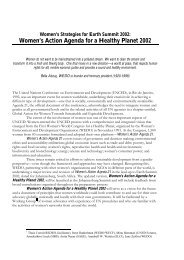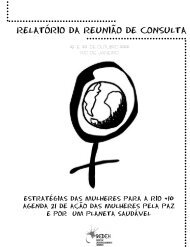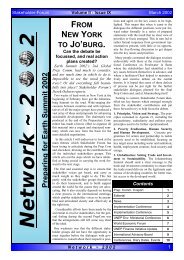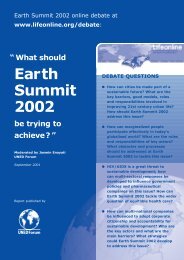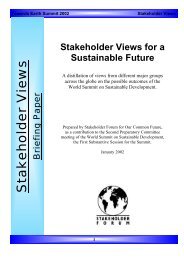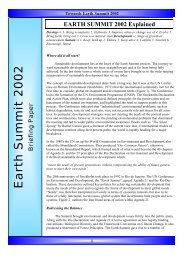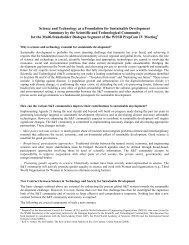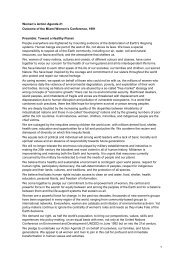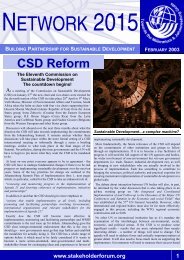Capacity Building for Partnerships - Earth Summit 2002
Capacity Building for Partnerships - Earth Summit 2002
Capacity Building for Partnerships - Earth Summit 2002
You also want an ePaper? Increase the reach of your titles
YUMPU automatically turns print PDFs into web optimized ePapers that Google loves.
CAPACITY BUILDINGBUILDING PARTNERSHIPS FOR SUSTAINABLE DEVELOPMENT APRIL 2003<strong>Capacity</strong> <strong>Building</strong>For Sustainable Development<strong>Partnerships</strong>A Template <strong>for</strong> Stakeholders,Governments, and AgenciesBy Minu Hemmati & Robert WhitfieldStakeholder Forum <strong>for</strong> Our Common FutureSTAKEHOLDER FORUM • APRIL 2003 1
CONTENTS• Introduction• Goals• Content• Methodologies• Preparations• Examp le: <strong>Capacity</strong> <strong>Building</strong> <strong>for</strong> a Regional Implementation Forum• Annex I: Bali Guiding Principles <strong>for</strong> <strong>Partnerships</strong>• Annex II: Principles of <strong>Partnerships</strong> <strong>for</strong> Sustainable Development• Annex III: A Checklist <strong>for</strong> <strong>Partnerships</strong> <strong>for</strong> Sustainable DevelopmentNote: Annex’s are available in the online version only at: www.earthsummit<strong>2002</strong>.orgINTRODUCTION<strong>Partnerships</strong> <strong>for</strong> sustainable development are not new but have been brought to the <strong>for</strong>e within the Johannesburg <strong>Summit</strong> process.They require an enabling environment of good governance and adequate financing mechanisms. They also require effectivecommunication and collaboration among different stakeholders and sectors. The present paper is focusing on the latter.In order to be designed and implemented successfully, interested parties and those facilitating partnership initiatives often need toexpand their knowledge and skills, and establish a common base of working together, among them being:• Knowledge about the integrative concept of sustainable development, existing agreements and processes;• Understanding the notion of stakeholders in sustainable development;• Understanding communication and collaboration in highly diverse groups;• Management, finance, and administration skills.This paper aims to suggest goals, components, and methodologies <strong>for</strong> capacity building programmes that aim to enable stakeholders,governments, and agencies to successfully engage in partnerships <strong>for</strong> sustainable development. The principle goal of suchprogrammes is to increase implementation of sustainable development in a range of areas, through the following aims:Such programmes are meant to:• Increase capacities of all stakeholders to effectively design, initiate and implement partnerships <strong>for</strong> sustainable development;• Increase the effectiveness of existing partnerships <strong>for</strong> sustainable development;• Improve networks and knowledge building among organisations engaged in partnerships;• Improve the quality of policy decisions through increased capacity of stakeholders to feed their knowledge into decision-making.The programme outlined below is a suggested template that can be used to develop capacity-building programmes <strong>for</strong> partnerships.It offers a possible scope of relevant components and methodologies, rather than a large, prescriptive set to be addressed. Goals (2.),content (3.) and methodologies (4.) will need to be adapted to the respective contexts and needs of potential participants. There<strong>for</strong>e,we are suggesting a consultative process to be used when designing the capacity-building programme (5.). For the purpose ofillustration, we have also included an example (6.).Annexes I-III provide background material on partnerships and the principles and strategies of multi-stakeholder processes.STAKEHOLDER FORUM • APRIL 2003 2
GOALS<strong>Capacity</strong> building <strong>for</strong> sustainable development partnerships aims to contribute to the achievement of the following goals:• Enable all stakeholders to successfully initiate, design and implement partnerships <strong>for</strong> sustainable development;• Enable all stakeholders to effectively monitor and evaluate their partnership ef<strong>for</strong>ts, and learn from their experiences;• Enable all stakeholders to effectively feed their experience and expertise into policy making;• Strengthen the stakeholder community as a whole and those engaged in partnerships by increasing professionalism andeffectiveness; and• Enable "trained" stakeholders to carry out similar capacity building programmes among their constituencies.through:• <strong>Building</strong> necessary background knowledge of sustainable development and relevant decision-making processes at theinternational, regional, sub-regional, national and local levels;• Addressing the intellectual, practical and personal challenges of a partnership approach to sustainable development;• Learning about tools and techniques <strong>for</strong> designing and implementing partnerships; and• Learning about the processes used to design, implement and evaluate the capacity-building programme itself.Looking at the knowledge and skills that help to create successful multi-stakeholder partnerships leads to defining the followingcomponents <strong>for</strong> capacity building programmes:CONTENTSustainable developmentRationale: The concept of sustainable development is complex and so are the political, social and economic processes related to itsrealisation. Potential partners should have a solid knowledge of the concept, its three pillars, it's analytical differentiation intosectoral and cross-sectoral issues and the importance of good governance and enabling environments.<strong>Partnerships</strong> <strong>for</strong> sustainable development should aim to contribute to the implementation of sustainable development agreements, themost prominent recent ones being the Millennium Development Goals and the goals and targets set at the Johannesburg <strong>Summit</strong>. Inorder to do that, potential partners need to be well aware of the priorities set in those agreements and the continuing policy andreview processes relating to them, at the various levels. Potential partners also need to gain an understanding of existing and plannedimplementation programmes as well as partnerships – and how to get that in<strong>for</strong>mation - so as to be able to identify the specificcontribution any potential partnership can make.Components:• Sustainable development and its components: environmental, social and economic pillars and their inter-linkages• Good governance and sustainable development; the multi-stakeholder approach and questions of democracy (legitimacy;participation);• Knowledge about the relevant international agreements, primarily the Millennium Development Go als (MDGs) and theJohannesburg Plan of Implementation;• Knowledge about relevant institutions and processes that operate in support of partnerships <strong>for</strong> sustainable development, eg UNand other bodies;• The international, regional and national political roadmaps <strong>for</strong> the next five years with a particular focus on the MillenniumDevelopment Goals and implementation of the Johannesburg outcomes; and• Existing implementation programmes and partnerships <strong>for</strong> sustainable development. Scoping what is going on will enable theprospective partners to identify their possible contribution as well as necessary linkages and potential additional partners;Stakeholders and multi-stakeholder collaborative actionRationale: It has been agreed that sustainable development, although established as an overarching concept in intergovernmentalprocesses, is not something that governments and agencies can achieve on their own. It takes the contribution of all stakeholders andtheir individual and collective actions to bring about the changes required. Innovative solutions to complex problems can be createdSTAKEHOLDER FORUM • APRIL 2003 3
when diverse stakeholders are able to share their knowledge, learn together and develop a collective approach. In successful multistakeholderpartnerships, partners share risks, pool resources and talents and deliver mutual benefits <strong>for</strong> each partner. As such, theydevelop collective commitment and capacity to turn ideas and plans into action.Potential partners should have a solid understanding of the roles and responsibilities of all stakeholders, including governmental andintergovernmental bodies, in sustainable development. This will enable them to develop a better understanding of the perspectives,interests, cultures and behaviour of representatives of different stakeholder groups. It will also enable them to identify moreeffectively their own tasks and other potential partners <strong>for</strong> their ef<strong>for</strong>ts and the barriers they might encounter. Understandingstakeholders and the concept of partnerships will also help people to identify if setting up a partnership is indeed the appropriateapproach <strong>for</strong> a particular problem. <strong>Partnerships</strong> that take on tasks that they cannot or should not aim to deliver cannot be successfulor run the risk of making a detrimental contribution in the medium and long term.Components:• Understanding the notion of stakeholders in sustainable development and the general concept of multi-stakeholder approaches;• Knowledge about the respective roles and responsibilities of all stakeholders in achieving the MDGs and Johannesburg <strong>Summit</strong>outcomes;• Skills of analysing the issues at hand vis -à-vis the potential contributions and interests of stakeholders so as to identify therelevant stakeholder groups and potential partner organisations;• Thorough reflection of every potential partner's interests and capacities;• Understanding the role of partnerships <strong>for</strong> sustainable development as one component of the array of mechanisms that need to beput in place (and/or scaled up) to deliver the sustainable development agreements;• Understanding possible processes and mechanisms of developing and implementing a partnership: from identifying issues,relevant stakeholders and an appropriate size of the group; to developing a shared vision, goals and objectives; to identifying theoptimal division of roles and sharing of risks; to possible governance structures <strong>for</strong> the partnership (see Annex III <strong>for</strong> a checklistof key points to address when developing a partnership); and• Understanding the possible societal value of partnerships, ie improved communication and collaboration between diverse peopleand groups, and the unity-building power of successful joint action.Communication and collaboration in diverse groupsRationale: Multi-stakeholder partnerships by their very nature require people of different backgrounds, perspectives, interests, andcultures to communicate and work together. This is a difficult task <strong>for</strong> anybody, and will be even more so when addressing issuesand tasks of high complexity such as sustainable development. Developing a better understanding of the effects of such diversity,including power dynamics and power gaps, can help to improve communication and collaboration and to avoid process failures overcommunication barriers. Successful multi-stakeholder processes develop collective commitment and capacity to turn ideas and plansinto action.Comp onents:• Understanding communication, group processes (power dynamics, leadership, ownership, commitment, etc) within a context ofhigh diversity of backgrounds, values, and interests;• Developing skills relating to effective communication, networking and negotiation that build trust and clarity among participants;• Understanding of the value of facilitators (honest brokers) in a mult i-stakeholder setting;• Developing facilitation skills that help to run effective meetings, identify partners’ respective interests and contributions, creatingshared visions,• Understanding one’s personal strengths and weaknesses in relation to a multi-stakeholder setting, challenges of leadership andteam work; skills of active listening and constructive dialogue; summarising and feedback; and• Advocacy skills to effectively relate to decision-making <strong>for</strong>a, feeding experiences and knowledge gained into official policymaking.Realising the components from the paragraphs addressing Sustainable Development and Stakeholders & Multi-Stakeholdercollaborative action above should be done using concrete examples of issues and problems that potential partnerships could address.Such issues should be identified when developing the capacity building programme so that exercises will address what is relevant toparticipants (see below).Tools <strong>for</strong> managing a project/partnershipRationale: The group developing a partnership <strong>for</strong> sustainable development also needs to develop a shared understanding of theirstrategies, which is helped by having a number of management and research tools at their disposal. Such tools come under differentnames but they all aim to help develop step-by-step work programmes, identify roles and responsibilities, and identify critical stepsand indicators of success and failure. Similarly, any partnership will have to be financed, by the partners themselves or by externalsources of investment, grant funding, or other sources. Finally, any partnership needs to be monitored, internally and/or externally,STAKEHOLDER FORUM • APRIL 2003 4
and it will need to report on its progress, be it to financing bodies or political processes (such as WSSD follow-up).Components:• Project management, risk management and similar tools <strong>for</strong> planning a project, identifying a work programme, and identifyingroles and responsibilities;• Understanding business plan development;• Skills to help initiate investments and raise funds, including knowledge about potential sources of investment / funding;• Effective use of in<strong>for</strong>mation and communication technologies, including the Internet, telephone conferencing, etc; and• Monitoring, evaluation and reporting tools and their adaptation to a particular partnershipMETHODOLOGY<strong>Capacity</strong> <strong>Building</strong> Workshops: Actual capacity building workshops should use a variety of training methodologies, <strong>for</strong> example:• overview presentations and panel discussions in plenaries; trainers can be sustainable development issue experts and people whoare running partnerships elsewhere to share their knowledge and experience• specific tasks in small groups, using professional facilitation;• simulation games (eg <strong>for</strong> negotiation);• researching relevant organisations and materials using the Internet;• developing participants' own case studies; and• writing scoping papers on issues, relevant stakeholders.It is also imp ortant to create an agenda of mixed activities with sufficient time <strong>for</strong> individual and group reflection and <strong>for</strong>networking.All components should be facilitated professionally and draw on the knowledge and skills of, ideally, a range of trainers. Theseshould generally come from the same cultural and language background as participants; sometimes, however, it can be useful to addan outside perspective.Facilitators and trainers should be well prepared, understanding the goals and purposes of the programme and the process by whichit is being set up. It is important to include them in the programme design and draw on their expertise in terms of developingagendas, determining group sizes, etc.It is important to have training materials available in languages and styles most accessible <strong>for</strong> participants. Using materials alreadydeveloped elsewhere avoids duplicating ef<strong>for</strong>ts. Improving materials over time will be based on practical experience and can beimproved by using appropriate evaluation tools. It should be considered to make all in<strong>for</strong>mation about the programme, including thematerials used, available to others as well, eg via a website.Longer Term Programmes: These can benefit from an action research approach where participants engage in building partnershipsthrough the course of the programme and use the programme to reflect, monitor, and improve their activities. They can also includeparallel participation in training courses, such as management; finance; or facilitation. Linkages to appropriate universityprogrammes should be explored; in many cases, there are scholarships available, particularly <strong>for</strong> participants from developingcountries.Evaluation: work with universities and other independent research institutions to monitor and evaluate the programme and its shortandlong-term effects.STAKEHOLDER FORUM • APRIL 2003 5
PREPARATIONSIt is crucial to secure the support and active engagement of key partners (including funders) to make the capacity buildingprogramme a reality. One method is to begin working with a small group of advisors that can be developed into a ProgrammeAdvisory Group who will guide the programme from its inception to its completion.In order to ensure engagement and commitment, all relevant stakeholders should be consulted with regard to:• Areas of capacity building to be addressed - the above mentioned components can serve as a list to work from to identify thegaps that the programme shall address;• Scoping existing capacity building programmes and materials that can serve the desired purposes or parts of them - there is noneed to re-invent the wheel when we know what is already available;• Main areas <strong>for</strong> potential stakeholder collaboration - these should be relevant issues in the respective area (eg geographical ortopic area) and existing or potential partnerships and good practices to use as examples. This will help to make the programmeless abstract and more immediately relevant to participants.• Potential participants, including criteria <strong>for</strong> participation and outreach mechanisms - participants should constitute a diversegroup of potential multipliers who will then transfer this knowledge to others;• Effective trainers and facilitators, preferably to <strong>for</strong>m a gender balanced group from the same region / country;• Appropriate methodologies of capacity building; and• Appropriate approaches to monitoring, evaluating and reporting about the programme.Annex III provides a more detailed check-list that a group designing a programme might want to address during the preparatoryphase.EXAMPLES<strong>Capacity</strong> <strong>Building</strong> Process <strong>for</strong> a Regional Implementation ForumThe following is an example of a capacity building programme designed to enable participants to more effectively engage inpartnerships <strong>for</strong> sustainable development.It has been developed <strong>for</strong> the "Implementation Conference Africa. Stakeholder Action <strong>Partnerships</strong> <strong>for</strong> Sustai nableDevelopment in Africa" programme that is being developed by the Government of Ghana and Stakeholder Forum in collaborationwith a number of regional African bodies. This programme is designed to be able to <strong>for</strong>m the stakeholder part of the RegionalImplementation Forum <strong>for</strong> Africa, as envisaged in the UN Secretary General's Report <strong>for</strong> CSD-11 (April 2003).The Implementation Conference Africa programme is intended to contribute to the realisation of the Millennium Development Goalsand the targets set in the Johannesburg Plan of Implementation. Objectives of the Implementation Conference Africa programmeinclude:• Empower stakeholders to fulfil their role in sustainable development policy making and implementation;• Strengthen the capacity of African stakeholders to contribute through collaboration to the effective and responsiveimplementation of the outcomes of the Johannesburg <strong>Summit</strong> and Millennium Development Goals;• Bring together stakeholders from different backgrounds to develop and commit to concrete, agreed and owned collaborativeaction plans aimed at implementing a common agenda <strong>for</strong> the region’s sustainable development, building on and strengtheningexisting initiatives and initiating new ones;• Promote exchange of in<strong>for</strong>mation and knowledge among stakeholders engaged in partnerships <strong>for</strong> sustainable development;and• Promote and strengthen intra-regional networking between stakeholders.Here, "capacity building <strong>for</strong> partnerships" <strong>for</strong>ms an integral part of a programme that begins with a consultative process ofprogramme development among the partner organisations and relevant stakeholders, <strong>for</strong>ming a Programme Advisory Board. Thiswill also include jointly developing the content and methodologies of the capacity building programme, that then leads into thepractice of partnership building by initiating multi-stakeholder groupings that create joint action plans. Follow-up and knowledgebuilding <strong>for</strong>ms an integral part of the exercise to continue to monitor the partnerships and help them succeed.The issues that shall be used <strong>for</strong> the capacity building programme will be identified by combin ing a top-down and a bottom-upSTAKEHOLDER FORUM • APRIL 2003 6
approach: On the one hand, taking the lead from the international agreements and the priorities set in the international process (suchas by CSD11), on the other hand, stakeholders identifying what is most urgently relevant in their countries and their region. In orderto define concrete, specific examples, the partners will endeavour to address cross-sectoral issues such as poverty, consumption,good governance, or conflict resolution, within the sectoral issues – <strong>for</strong> example: using joint ef<strong>for</strong>ts addressing water problems tobuild peace between conflicting communities.By using concrete examples <strong>for</strong> the capacity building programme, the capacity building will also help to lay the groundwork <strong>for</strong> thedevelopment of partnerships more effectively: identifying relevant stakeholders or existing implementation ef<strong>for</strong>ts, <strong>for</strong> example, aspart of an exercise in the capacity building phase, can be directly used in the subsequent stakeholder action phase.Phased ProgrammeSTAKEHOLDER FORUM • APRIL 2003 7
STAKEHOLDER FORUMCHAIRDavid Hales & Gwen MalangwuHONORARY VICE PRESIDENTSHenrique Cavalcanti, Jaun Mayr, BedrichMoldan, Mustafa Toulba, Simon UptonSTAFFFelix Dodds Executive Director; Rosalie GardinerHead of Policy & Research; Toby MiddletonHead of Communications; Georgina Ayre UNEDUK Co-ordinator; Minu Hemmati ConsultantRobert Whitfield MSP Programme Co-ordinator;Rebecca Abrahams Kiev 2003 Adviser; BethHiblin International Administrator; HamidHoushidar Finance Officer; Aretha MoorePersonal Coordinator to the Director; TrevorRees Kiev 2003 Project Co-ordinator; GordonBaker Project Co-ordinator; Michael BurkeProject Co-ordinator, Prabha ChoubinaConnections , Irene Gerlach Project Co-ordinator,Claire Rhodes Project Co-ordinatorNTERNATIONALADVISORY BOARDAction Canada <strong>for</strong> Population and DevelopmentZonny Woods; ANPED Pieter van der Gaag;Arab Network <strong>for</strong> Environment & DevelopmentEmad Adly; Baha’i International CommunityPeter Adriance; CIVICUS Kumi Naidoo; Centre<strong>for</strong> Science & Environment Sunita Narain; Centrode Estudios Ambientales Maria Onestini;Com monwealth Women’s Network Hazel Brown;Consumer Research Action and In<strong>for</strong>mationCentreRajat Chauduri; Development AlternativesAshok Khosla; Formerly Dutch GovernmentHerman Verheij; Eco Accord Victoria Elias;Environment and Development Action (Maghreb)Magdi Ibrahim; Environment Liaison CentreInternational Barbara Gemmill; HuairouCommission Jan Peterson; European Rio+10Coalition Raymond van Ermen; Friends of the<strong>Earth</strong> Scotland Kevin Dunion InternationalChamber of Commerce Jack Whelan;International Confederation of Free Trade UnionsLucien Royer; International Council <strong>for</strong> LocalEnvironmental Initiatives Konrad Otto-Zimmerman; International Council <strong>for</strong> SocialWelfare Nigel Tarling; International Institute <strong>for</strong>Environment and Development Nigel Cross;International Institute <strong>for</strong> SustainableDevelopment Kimo Langston James Goree VI;International Partners <strong>for</strong> Sustainable AgricultureLinda Elswick; IUCN Scott Hajost; InternationalUnion of Local Authorities Jeremy Smith;Leadership <strong>for</strong> Environment & Development JuliaMarton-Lefèvre; Liaison Committee ofDevelopment NGOs to the EU Daphne Davies;Justice & Sustainability Associates MencerDonahue Edwards; Participatory Research inAsia Rajesh Tandon; Peace Child InternationalDavid Woollcombe; Poptel Worldwide MalcolmCorbett; Stockholm Environment InstituteJohannah Bernstein; South Africa FoundationNeil van Heerden; Stakeholder Forum DerekOsborn; Stakeholder Forum Margaret BrusascoMac kenzie; UNA UK/WFUNA Malcolm Harper;UN Environment Programme Klaus Töpfer;Women’s Environment and DevelopmentOrganisation June Zeitlin; World BusinessCouncil <strong>for</strong> Sustainable Development ClaudeFussler; World In<strong>for</strong>mation Transfer ClaudiaStrauss; World Resources Institute JonathanLash; WWF International Gordon Shepherd.CAPACITY BUILDINGSTAKEHOLDER FORUMCONTACT7 Holyrood StreetLondon SE1 2ELUnited KingdomTel +44 20 7089 4300Fax +44 20 7089 4310email: minush@aol.comrwhitfield@earthsummit<strong>2002</strong>.orgSTAKEHOLDER FORUM • APRIL 2003 8


